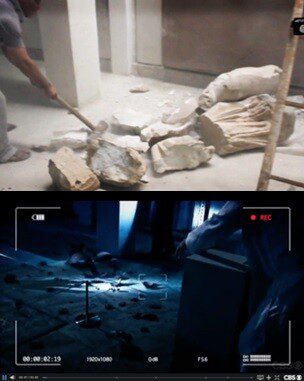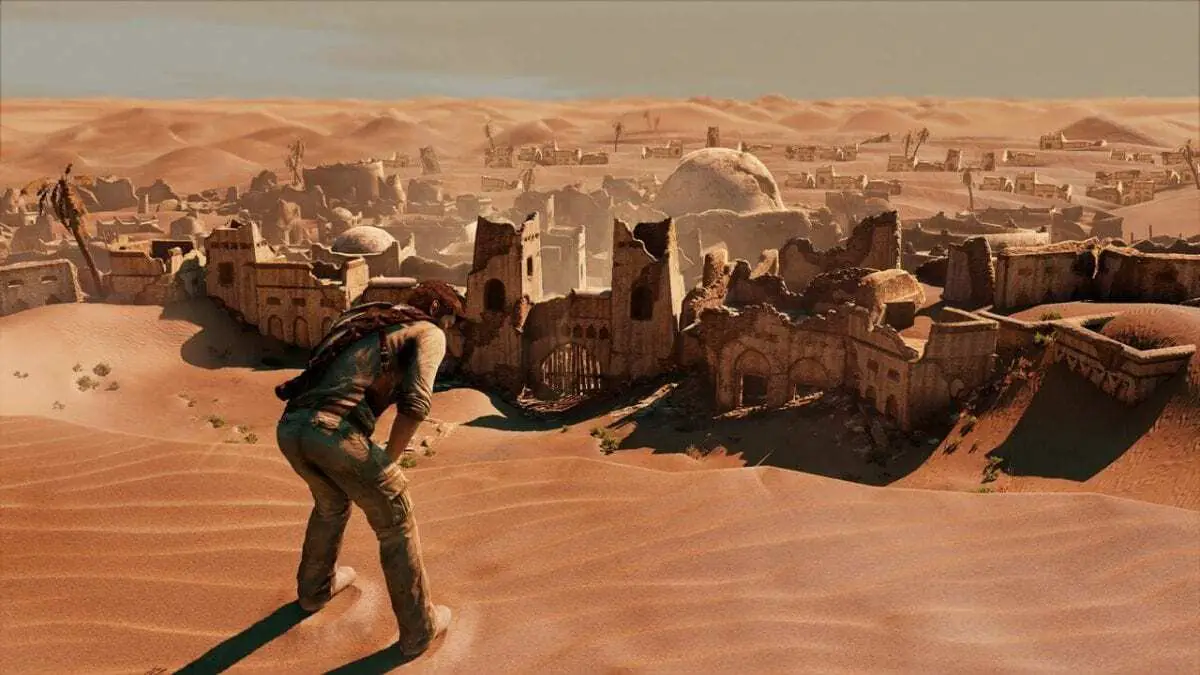Note: This article contains spoilers for the “Uncharted: Lost Legacy” game.
The looting and destruction of antiquities and archaeological sites has plagued countries facing terrorism, conflict, and instability for decades. But conflicts in the Middle East and North Africa (MENA) have taken center stage in recent years following the rise of ISIS.
As with any monumental global challenge, the recent crises have become the topics of popular culture stretching from television comedies, to drama, and even video games.
Images such as the destruction of Palmyra in Syria and the Mosul Museum in Iraq have become iconic reminders of how culture can be used as a weapon of war. Yet while these iconic images permeate the minds of archaeologists and policy makers, the greater American public is (understandably) not paying the same level of attention to the archaeologically-connected details of terrorist financing.
But the popularization of story lines related to ISIS, and to terrorism more broadly, has opened a new public audience to the very real threats facing our history. Threats to cultural heritage have made their way out of academic journals and policy papers and into the homes of millions of viewers around the world.
Destruction in Dramas
 The hit CBS series Madam Secretary, which averages more than 14 million viewers, spent its third season diving headfirst into the terrorism-antiquities connection.
The hit CBS series Madam Secretary, which averages more than 14 million viewers, spent its third season diving headfirst into the terrorism-antiquities connection.
In the Show: Season 3, episode 2 “The Linchpin” begins with scenes that mirror one found across global headlines in February 2015: a dimly lit museum disrupted by the sounds of smashing antiquities as terrorists film themselves destroying ancient statues with sledgehammers.
In Reality: While the show may depict a fictional terrorist group in Algeria, the premises this is based on are a devastating reality for countries like Iraq where ISIS has committed these very acts, most notably in their deliberate destruction of the Mosul Museum.
Madam Secretary’s “The Linchpin” had more than 9 million viewers on the evening it aired. And while the show is merely a reflection of real life, the decision to make antiquities a central issue of the episode included real policy challenges faced on this very issue today.
In the Show: As the Elizabeth McCord (played by Téa Leoni) and Henry McCord (Tim Daly) discuss the devastation the remaining sites in the country may face, they ponder the options that could help save them. Elizabeth remarks, “State has a program to try and protect UNESCO sites but there’s barely any funding.”
In Reality: Fast forward to the present as the current administration eyes budget cuts to the State Department and critical heritage funding programs like the National Endowment for Humanities (NEH), these budget cuts are a very real obstacle in the way of our policy options to protect culture under threat today.
How much impact has this show had? Even lawmakers have paid attention to the issue as a result of this popular culture exposure. At a June 2017 House Financial Services Committee hearing entitled “The Exploitation of Cultural Property: Examining Illicit Activity in the Antiquities and Art Trade,” ranking member of the Committee Rep. Ed Perlmutter of Colorado stated that he only knew about this issue as a result of its appearance on the show: “My experience of this comes mostly from watching Madam Secretary and the episodes they’ve had regarding stolen art and the destruction of antiquities.”

Gaming the Traffickers
While destruction is a central focus of some dramas, the idea of “tomb raiding” and “treasure hunting” draws different audiences. In August 2017, gaming developer Naughty Dog released “Uncharted: The Lost Legacy” for PlayStation 4, and while tomb-raiding games are nothing new, this one has some familiar parallels to what’s happening today.

In the Game: Set in India on the brink of civil war, the game centers on its two heroines (Chloe Frazier and Nadine Ross) securing the precious Tusk of Ganesh so that it does not fall into the hands of the insurgent leader and notorious antiquities trafficker, Asav. As they examine Asav’s stolen antiquities trove, Nadine asks Chloe “How much do you think it’s all worth?” Chloe replies, “Enough to keep his little insurrection going for quite some time.” He has been using looted antiquities to fund his terrorist activity and prolong the conflict, eventually utilizing the Tusk of Ganesh as payment to mercenaries for a bomb he plans to set off and send the country into full blown civil war. In the end, our two heritage (s)heroes defeat the trafficker, stop the bomb, and retrieve the Tusk – which they promptly decide to return to the Ministry of Culture rather than sell to a private collector for a larger financial gain.
In Reality: Of course unlike the game, India is not a country on the brink of civil war, however it is home to one of the kingpins of the antiquities trafficking world – Subhash Kapoor. Kapoor’s global antiquities trafficking operation included Manhattan, where he owned an antiquities gallery on Madison Avenue. As U.S. authorities built a case against him they seized more than $107 million worth of antiquities from India and southeast Asia that were confiscated from his New York warehouses.
Although Kapoor may not have been trafficking antiquities to fund a terrorist insurgency, one trafficker who was using antiquities to fund terrorist activity also served as a leading commander of ISIS. When U.S. Special Forces raided the compound of ISIS commander Abu Sayyaf in May 2015, they found documents recording an intricate antiquities trafficking scheme with receipts that amounted to roughly $1.25 million for just a three-month period. The diversified financing resources – including antiquities – utilized by ISIS has helped the group fund one of the most devastating insurgencies to ever hit the MENA region.
Another bonus of “Lost Legacy” that mirrors real life: throughout the game Chloe can pull out her smartphone to snap pics of the incredible sites she visits – a reminder that documentation, even in games, is always important.
Combating Looting with Comedy
Antiquities trafficking hasn’t just been a source of storyline inspiration for intense games and television dramas, comedy has also taken a stab at the topic. In Season 2 of the Netflix series The Unbreakable Kimmy Schmidt, writers used one episode as a way to dig into layers of the antiquities trafficking issue.
In the Show: In Season 2, Episode 3 “Kimmy Goes to a Play!” socialite Jacqueline White (played by Jane Krakowski) tries to think about how she will explain her empty new apartment to others in her social circle so they don’t suspect that she has financial troubles after her divorce. The response she devises pokes fun at how buyers of illicit antiquities may often ignore real warning signs. Jacqueline suggests, “For a few months I could pretend to be dealing with the decorator – or waiting for the wall hangings to get out of Syria. These sanctions are killing me!”
The episode parallels these challenges with the wall hanging that is already in her apartment, a painting she invested her final millions into – one that the series eventually reveals was looted by the Nazis during the Holocaust. As shallow as Jacqueline’s response on her imaginary Syria pieces was, her response to Holocaust restitution is more meaningful. Initially fears giving up the painting because of her financial losses, but she eventually returns the piece after taking a look into her own roots, which are – wait for it – Native American, Lakota Sioux to be exact. Jacqueline finds out from her parents that a “secret society at Yale” finally agreed to return her grandfather’s skull to the reservation. She realizes that her family’s heritage has been pillaged and feels for the Jewish family seeking return of their long-lost, Nazi-looted art.
In Reality: These days, new legislation has made it a challenge to get wall hangings or any other antiquities into the U.S. from Syria. In 2016, President Obama signed into law H.R. 1493 – The Protect and Preserve International Cultural Property Act, which prohibits the import of antiquities from Iraq and Syria while their heritage is at risk from ongoing instability and conflict.
Holocaust art has become another target of legislation in recent years. In April 2016, S.2763 – The Holocaust Expropriated Art Recovery Act of 2016 was introduced in the Senate in an effort to help the Jewish community recover artwork that had been stolen from families by Nazis during WWII. Aside from legislation, groups like the Holocaust Art Restitution Project (HARP) document losses of Jewish art from WWII and help claimants with their retrieval of stolen pieces. In addition, the Jewish Virtual Library provides guidance on how to file a Holocaust art restitution claim, information this process is vital as families continue to recover their lost artwork.
The Native American community has also faced numerous instances of trafficking in their cultural heritage. While there are protections in place to thwart this trafficking at home, artifacts continue to be under threat. On June 21, 2017 U.S. Senator Martin Heinrich of New Mexico reintroduced one such protection. The bipartisan Safeguard Tribal Objects of Patrimony (STOP) Act, would prohibit the export of sacred Native American objects and increase penalties for illegally trafficking Native cultural property. One of the bill’s co-sponsors Tom Udall of New Mexico called the trafficking of Native artifacts “an assault on the cultural identity of Native American Tribes” noting, “Native Americans have been the victims of theft and looting for generations. We have passed laws to stop it, but people are exploiting the loopholes in our current laws to sell these objects as art.”
The writers of The Unbreakable Kimmy Schmidt managed to embed multiple antiquities threats into their series — inception-style. This meta-episode on culture under threat highlights over a century of illicit trafficking in heritage that has deep connections to the communities it belongs to.
American television may have one-off episodes highlighting the cultural issues of our times, but when it comes to antiquities Egypt is never to be out done. This year, Egyptian writer Ahmad Al-Nahhas announced that he has developed an entire show dedicated to the issue of looting. Looting has plagued Egypt’s heritage for centuries, but since the Arab Spring in 2011 the problem has sharply risen as the process has industrialized.
The 30 episode series entitled “Al Lakia” was meant to be more than just a hit television series. The show’s director and writer Al-Nahhas wants to use the series as a platform to help inform the public on the importance on protecting heritage by using a topic that touches the lives of many Egyptians. Though Egypt is a major source country for antiquities, their recent bilateral cultural agreement with the United States signed in 2016 helped curb imports to one of the largest consumer nations for art and antiquities.
From market country media to source country series, it’s clear that the issue of antiquities in popular culture won’t be going away anytime soon, ensuring new audiences and demographics continue to be exposed to the importance of saving our past through their consumption of popular culture. Whether on eBay or at a gallery in Manhattan, buyers of antiquities should always beware of where their artifacts come from.

Written by Katie A. Paul






